Aggregation Dispatch and Control Strategies for Multi-Type Loads in Industrial Parks
Abstract
1. Introduction
- The paper abstracts and unifies the multidimensional control-response characteristics of multi-type of controllable loads in industrial parks, including control-delay characteristics, start–stop characteristics, and control-response-speed characteristics, and establishes a phased response model for controllable loads. This lays the foundation for achieving precise system-level control in industrial parks.
- Establish a day-ahead and intra-day aggregate optimization dispatch model for an industrial park that includes controllable loads with multidimensional control response characteristics. The optimization dispatch objective is to minimize the overall operation cost of the industrial park. A two-stage solving method is implemented to transform the mixed-integer nonlinear programming problem into a mixed-integer linear programming problem, achieving efficient solutions for both day-ahead optimization dispatch and intra-day rolling optimization dispatch strategies.
- Based on the multidimensional control response characteristics and phased response model of controllable loads in the industrial park, a real-time forecast and control model for a single controllable load unit is established. The minimum variance control rate of the controllable load is calculated with the goal of minimizing the error while tracking the rolling optimization dispatch strategy. Precise control of controllable loads is realized through rolling forecasting and closed-loop optimization control.
2. Aggregated Dispatch and Control Framework for Multi-Type Loads in Industrial Parks
2.1. Control Characteristics of Multi-Type Loads in Industrial Parks
- Startup stage: After receiving a startup command, the controllable load starts from a shutdown state after a delay and operates under the specified conditions. The startup process can be regarded as zero initial-state step response with an invariant input, which is the inherent startup characteristic of controllable load, and can be described by a non-parametric model.
- Operation stage: The output power of controllable load can be adjusted within a certain range. After receiving a control command, it responds after a delay, and the response process is regarded as a non-zero state response, described by a non-parametric model.
- Shutdown stage: After receiving a shutdown command, the controllable load enters the shutdown stage after a delay, and its shutdown process can be regarded as a zero-input response, which is the inherent startup characteristic of the controllable load, and can be described by a non-parametric model.
2.2. Aggregated Control Framework for Multi-Type Loads in Industrial Parks
3. Aggregated Control Strategy for Multi-Type Loads in Industrial Parks
3.1. Day-Ahead Optimal Dispatch of Aggregated Multi-Type Loads in Industrial Parks
3.1.1. Day-Ahead Power Balance Equation of Industrial Park with Multi-Type Loads
3.1.2. Optimization Objective of Day-Ahead Dispatch
3.1.3. Constraints of Day-Ahead Dispatch
- Constraint on interconnection lines:
- Constraint on controllable load operation:
3.1.4. Day-Ahead Optimal Dispatch Strategy
3.2. Intra-Day Rolling Optimization Dispatch of Aggregated Multi-Type Loads in Industrial Parks
3.3. Real-Time Predictive Control of Multiple Types Loads in Industrial Parks
3.3.1. Real-Time Predictive Control Model
3.3.2. Real-Time Predictive Control Strategy
- Most controllable loads are first-order inertial objects with response-delay characteristics. The stability and robustness of these objects are influenced by the predicted time domain. It can be demonstrated that the stability and robustness of predictive control can be improved with a larger prediction time horizon. However, selecting a large prediction time horizon will lead to loss in control speed. In practical applications, it is advisable to select several hours as the appropriate prediction time horizon.
- Add a feedback correction process, utilizes real-time measured information to estimate and correct the effects of uncertainty. This approach can effectively overcome the impact of external uncertainty and internal uncertainty and improve the robustness of the proposed control model. Meanwhile, the robustness of the control model is influenced by the feedback correction coefficient. It can be demonstrated that the robustness of the control model can be improved with a smaller feedback correction coefficient.
3.3.3. Model Parameter Tuning
- Optimization horizon : Needs to match with the intra-day rolling optimization horizon, and covers the delayed response time and dynamic response time of the controllable load. Due to the intra-day rolling optimization horizon being 4 h, and the sum of delayed response time and dynamic response time of the controllable load not exceeding 4 h, the optimization horizon is selected as 4 h.
- Control horizon : Needs to satisfy . With a smaller , the computational workload for model solving decreases, but the tracking performance worsens. To achieve precise control of controllable loads, the control horizon is selected as 3 h.
- Sampling time : With a comprehensive consideration of hardware conditions, response dynamic characteristics, optimization horizon, control horizon, model dimensions, and control scale, the sampling time is selected as 15 min.
- Error weight matrix and control weight matrix : As the deviation assessment coefficient is consistent across all control time intervals, the error weight coefficient can be selected as . The control weight coefficient can be initially set to 0, and if there is excessive variation in control action, adjust the control weight coefficient to a higher value step by step.
- Feedback correction parameters : The selection of feedback correction parameters will affect the anti-interference capability and robustness of the control model. To improve the anti-interference capability, select .
4. Case Study
4.1. Scenario Description for the Case Study
- Scenario 1: The day-ahead optimal dispatch strategy of the industrial park is used as the execution strategy, and no further optimization control is performed on the controllable loads within the day, ignoring the response characteristics of the controllable loads.
- Scenario 2: Based on the day-ahead optimal dispatch plan of the industrial park, considering the forecast errors of photovoltaic power generation and rigid loads, the controllable loads are continuously rolling optimized and scheduled within the day, ignoring the response characteristics of the controllable loads.
- Scenario 3: Based on the intra-day rolling optimization dispatch plan in an industrial park, using a neural network model [27] to perform real-time control of controllable loads, and the specific steps are as follows: Firstly, based on the control inputs and the actual power output of controllable loads, the sample data are constructed to train the neural network model in order to describe the control-response characteristics of controllable loads. Secondly, based on the sample data of planned output power, a neural network model is trained to obtain a control input model, which allows controllable loads to follow the intra-day rolling optimization dispatch plan after receiving real-time control instructions.
- Scenario 4: Based on the rolling optimization and dispatch plan within the day of the industrial park and considering the response characteristics of the controllable loads, real-time predictive control is performed on the controllable loads.
4.2. Simulation Analysis
4.2.1. Analysis of Scenario One
4.2.2. Analysis of Scenario Two
4.2.3. Analysis of Scenario Three
4.2.4. Analysis of Scenario Four
- Based on the ultra-short-term power forecast results of photovoltaics and rigid loads, rolling optimization can be performed during the day to make the interconnection line power of the industrial park more accurately follow the optimized dispatch plan, reducing the execution deviation assessment and lowering the overall operating cost of the park.
- The real-time control model using neural networks cannot effectively reduce the execution deviation of controllable load units, industrial parks still need to bear significant assessment costs, and they cannot significantly reduce the overall operation costs of industrial parks.
- Considering the response characteristics (delay, response speed, etc.) of controllable loads and using minimum variance as the control objective, real-time predictive control of controllable loads can reduce the execution deviation of the controllable load unit and make the interconnection line power of the industrial park more accurately follow the rolling optimization dispatch plan during the day, further reducing the overall operating cost of the industrial park.
5. Conclusions
Author Contributions
Funding
Institutional Review Board Statement
Informed Consent Statement
Data Availability Statement
Conflicts of Interest
Nomenclature
| Sampling period | |
| Time instant, | |
| Output of the controllable load at time | |
| Control action at time | |
| Unit step response sequence of the controllable load in startup stage, operation stage, and shutdown stage | |
| Response delay of the controllable load in startup stage, operation stage, and shutdown stage | |
| The time required from receiving control command to entering a steady state in the startup stage, operation stage, and shutdown stage | |
| The time of issuing startup control command | |
| The starting time of entering the operation stage | |
| The starting time of entering the shutdown stage | |
| Power of the interconnection line at time | |
| Power of the inflexible load at time | |
| Power of the renewable energy generation at time | |
| Power of the controllable load at | |
| Number of controllable loads in the industrial park | |
| Total operation cost for day ahead | |
| Cost of purchasing and selling electricity at time | |
| Assessment cost for deviation at time | |
| Total number of dispatch periods for day-ahead | |
| Electricity price at time | |
| Day-ahead pre-dispatch plan for the interconnection line at time | |
| Positive deviation assessment price at time | |
| Negative deviation assessment price at time | |
| Maximum exchange power of interconnection line at time | |
| Maximum power limits during operation stage at time | |
| Minimum power limits during operation stage at time | |
| 1 indicates operation stage, indicates non-operation stage | |
| Minimum daily operation time | |
| Maximum daily operation time | |
| Maximum continuous operating time per start-up | |
| 1 indicates start-up stage, indicates non- start-up stage | |
| Duration of start-up stage | |
| Maximum times of start-ups per day | |
| Allowable time interval for daily operation | |
| The overall operating cost of the next 4 h starting from | |
| The start time of each intra-day rolling optimization | |
| Prediction horizon | |
| Control horizon | |
| Feedback correction coefficient | |
| Error weight matrix | |
| Control weight matrix | |
| Ideal reference value vector obtained from the daily rolling optimization |
References
- Liu, L.; Liu, T. A Control Strategy of Air-Conditioning Load Groups and Optimization Scheduling as Demand-side Resources Participating in Grid. Adv. Eng. Sci. 2017, 49, 175–182. (In Chinese) [Google Scholar] [CrossRef]
- Chen, S.; Chen, Q.; Xu, Y. Strategic Bidding and Compensation Mechanism for a Load Aggregator with Direct Thermostat Control Capabilities. IEEE Trans. Smart Grid 2018, 9, 2327–2336. [Google Scholar] [CrossRef]
- Liu, B. Scheduling Strategies of Smart Community with Load Aggregator-based Demand Response. In Proceedings of the 2018 2nd IEEE Conference on Energy Internet and Energy System Integration (EI2), Beijing, China, 20–22 October 2018; pp. 2–5. [Google Scholar] [CrossRef]
- Espinosa LA, D.; Almassalkhi, M. A Packetized Energy Management Macromodel with Quality of Service Guarantees for Demand-Side Resources. IEEE Trans. Power Syst. 2020, 35, 3660–3670. [Google Scholar] [CrossRef]
- Bian, D.; Shi, D.; Pipattanasomporn, M.; Kuzlu, M.; Rahman, S. Mitigating the Impact of Renewable Variability with Demand-Side Resources Considering Communication and Cyber Security Limitations. IEEE Access 2019, 7, 1379–1389. [Google Scholar] [CrossRef]
- Tostado-Véliz, M.; Hasanien, H.M.; Jordehi, A.R.; Turky, R.A.; Jurado, F. Risk-averse optimal participation of a DR-intensive microgrid in competitive clusters considering response fatigue. Appl. Energy 2023, 339, 120960. [Google Scholar] [CrossRef]
- Fu, X.; Zhou, Y. Collaborative Optimization of PV Greenhouses and Clean Energy Systems in Rural Areas. IEEE Trans. Sustain. Energy 2023, 14, 642–656. [Google Scholar] [CrossRef]
- Fu, X.; Zhou, Y.; Wei, Z.; Wang, Y. Optimal operation strategy for a rural microgrid considering greenhouse load control. CSEE J. Power Energy Syst. 2022, 1–11. [Google Scholar] [CrossRef]
- Tu, J.; Zhou, M.; Cui, H.; Li, F. An Equivalent Aggregated Model of Large-Scale Flexible Loads for Load Scheduling. IEEE Access 2019, 7, 143431–143444. [Google Scholar] [CrossRef]
- Wang, J.; Zhang, F.; Liu, H.; Ding, J.; Gao, C. Interruptible load scheduling model based on an improved chicken swarm optimization algorithm. CSEE J. Power Energy Syst. 2021, 7, 232–240. [Google Scholar] [CrossRef]
- Gao, C.; Li, Q.; Li, H.; Zhai, H.; Zhang, L. Methodology and Operation Mechanism of Demand Response Resources Integration Based on Load Aggregator. Autom. Electr. Power Syst. 2013, 37, 78–86. (In Chinese) [Google Scholar] [CrossRef]
- Sun, W.; Liu, X.; Xiang, W.; Li, H. Master-Slave Game Based Optimal Pricing Strategy for Load Aggregator in Day-ahead Electricity Market. Autom. Electr. Power Syst. 2021, 45, 159–167. (In Chinese) [Google Scholar] [CrossRef]
- Xu, H.; Chang, Y.; Zhao, Y.; Wang, F. A new multi-timescale optimal scheduling model considering wind power uncertainty and demand response. Int. J. Electr. Power Energy Syst. 2023, 147, 108832. [Google Scholar] [CrossRef]
- Do Prado, J.C.; Qiao, W. A stochastic decision-making model for an electricity retailer with intermittent renewable energy and short-term demand response. IEEE Trans. Smart Grid 2019, 10, 2581–2592. [Google Scholar] [CrossRef]
- Saavedra, A.; Negrete-Pincetic, M.; Rodríguez, R.; Salgado, M.; Lorca, Á. Flexible load management using flexibility bands. Appl. Energy 2022, 317, 119077. [Google Scholar] [CrossRef]
- Ryu, J.; Kim, J. Virtual Power Plant Operation Strategy under Uncertainty with Demand Response Resources in Electricity Markets. IEEE Access 2022, 10, 62763–62771. [Google Scholar] [CrossRef]
- Wang, S.; Bi, S.; Zhang, Y.J.A. Demand response management for profit maximizing energy loads in real-time electricity market. IEEE Trans. Power Syst. 2018, 33, 6387–6396. [Google Scholar] [CrossRef]
- Zhang, C.; Wang, Q.; Wang, J.; Pinson, P.; Morales, J.M.; Østergaard, J. Real-time procurement strategies of a proactive distribution company with aggregator-based demand response. IEEE Trans. Smart Grid 2018, 9, 766–776. [Google Scholar] [CrossRef]
- Zare Oskouei, M.; Zeinal-Kheiri, S.; Mohammadi-Ivatloo, B.; Abapour, M.; Mehrjerdi, H. Optimal Scheduling of Demand Response Aggregators in Industrial Parks Based on Load Disaggregation Algorithm. IEEE Syst. J. 2022, 16, 945–953. [Google Scholar] [CrossRef]
- Zhu, W. Research on Contract Decision Model for Load Aggregators Considering Uncertainty of User; North China Electric Power University: Beijing, China, 2016. (In Chinese) [Google Scholar]
- Wang, F.; Ge, X.; Li, K.; Mi, Z. Day-Ahead Market Optimal Bidding Strategy and Quantitative Compensation Mechanism Design for Load Aggregator Engaging Demand Response. IEEE Trans. Ind. Appl. 2019, 55, 5564–5573. [Google Scholar] [CrossRef]
- Cui, J.; Gao, M.; Zhou, X.; Li, Y.; Liu, W.; Tian, J.; Zhang, X. Demand Response Method Considering Multiple Types of Flexible Loads in Industrial Parks. SSRN Electron. J. 2022, 122, 106060. [Google Scholar] [CrossRef]
- Xu, G.; Liu, L.; Lu, Y.; Zhao, Y.; Zhang, L.; Song, S. Perception and decision-making for demand response based on dynamic classification of consumers. Int. J. Electr. Power Energy Syst. 2023, 148, 108954. [Google Scholar] [CrossRef]
- Zheng, S.; Sun, Y.; Qi, B.; Li, B. Incentive-Based Integrated Demand Response Considering S&C Effect in Demand Side with Incomplete Information. IEEE Trans. Smart Grid 2022, 13, 4465–4482. [Google Scholar] [CrossRef]
- Han, R.; Hu, Q.; Cui, H.; Chen, T.; Quan, X.; Wu, Z. An optimal bidding and scheduling method for load service entities considering demand response uncertainty. Appl. Energy 2022, 328, 120167. [Google Scholar] [CrossRef]
- Zhao, Z.; Guo, J.; Luo, X.; Lai, C.S.; Yang, P.; Lai, L.L.; Li, P.; Guerrero, J.M. Distributed Robust Model Predictive Control-Based Energy Management Strategy for Islanded Multi-Microgrids Considering Uncertainty. IEEE Trans. Smart Grid 2022, 13, 2107–2120. [Google Scholar] [CrossRef]
- An, S.; Wang, H.; Yuan, X. Real-time optimal operation control of micro energy grid coupling with electricity–thermal–gas considering prosumer characteristics. IEEE Access 2020, 8, 216566–216579. [Google Scholar] [CrossRef]


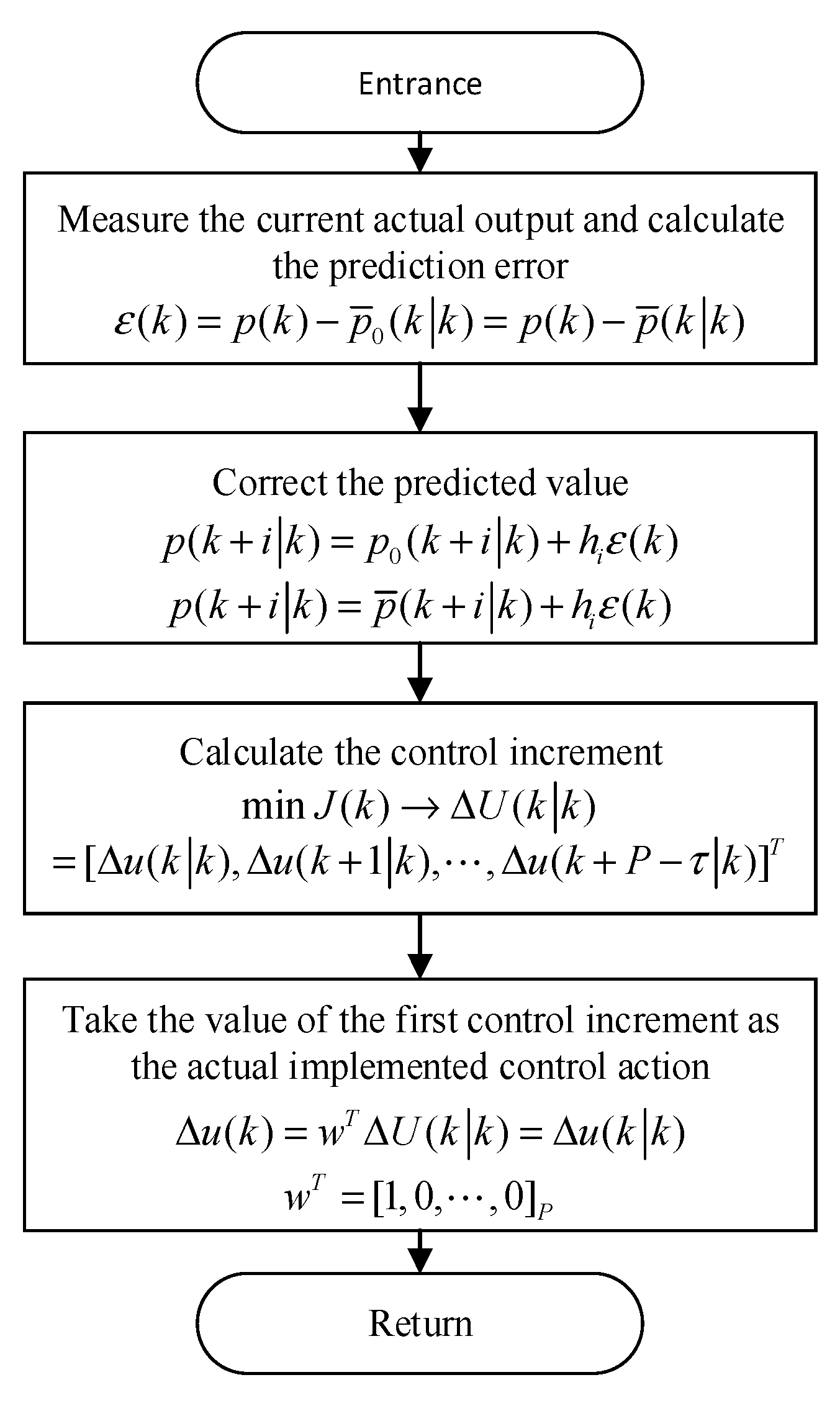
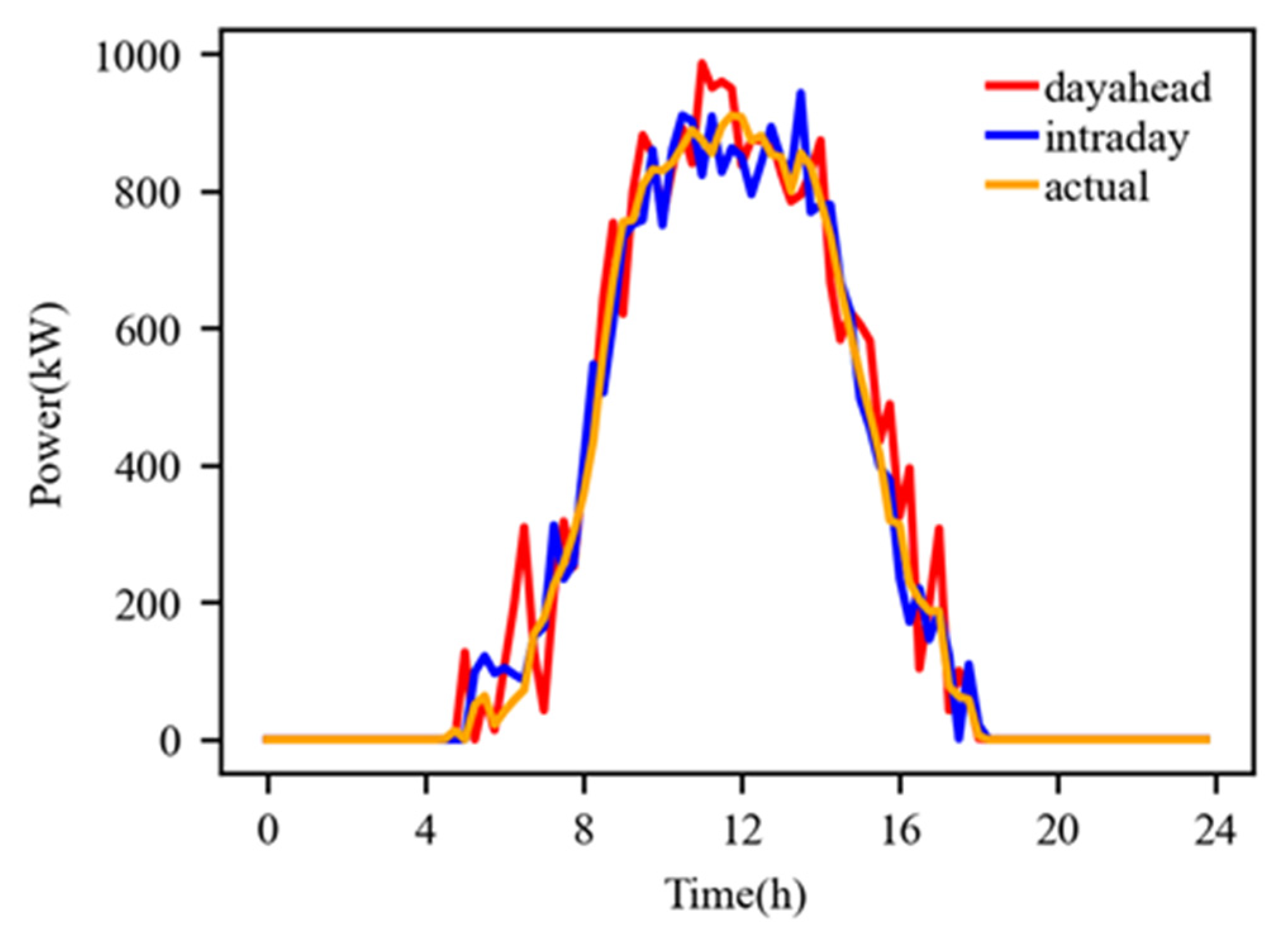



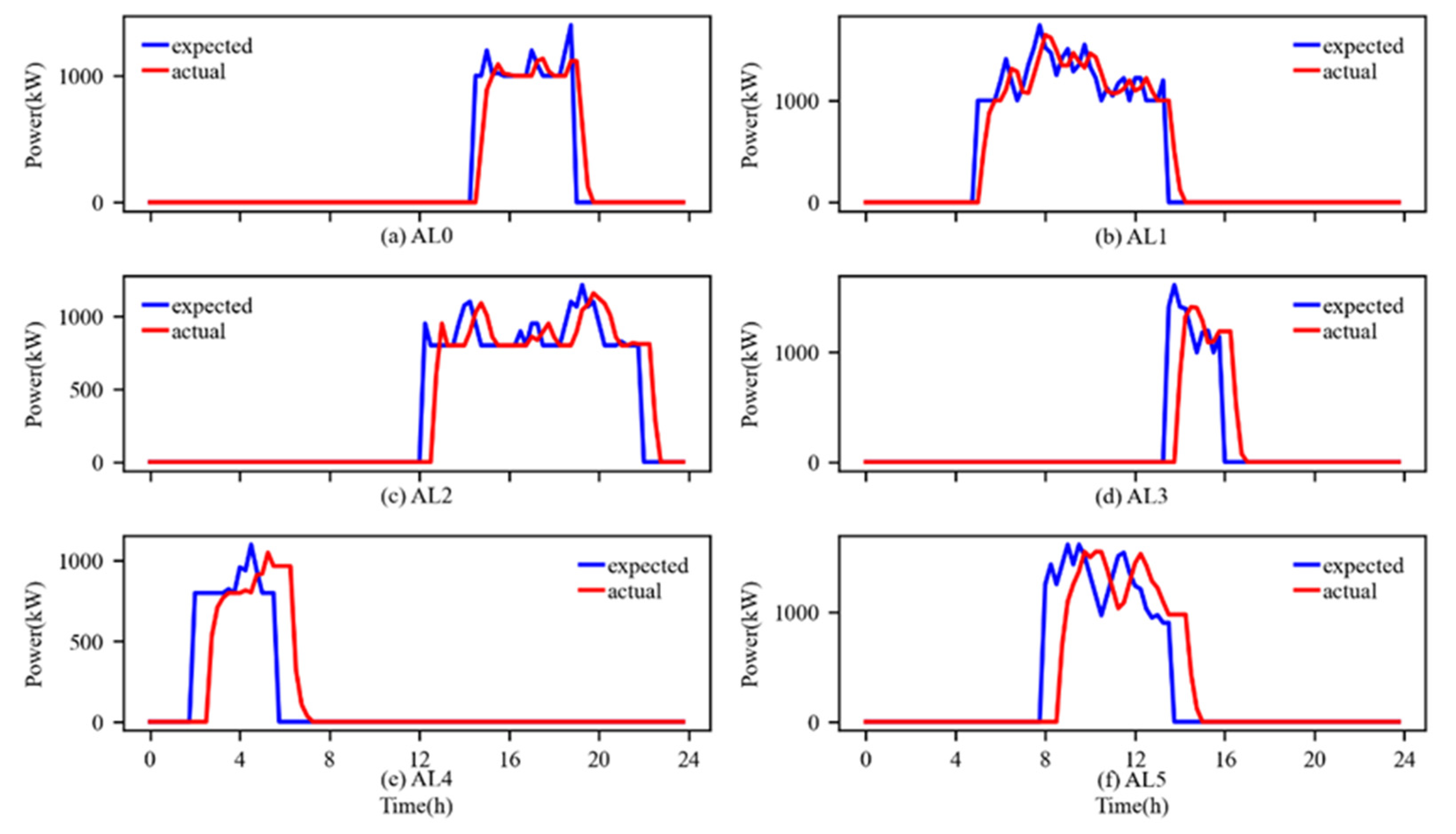
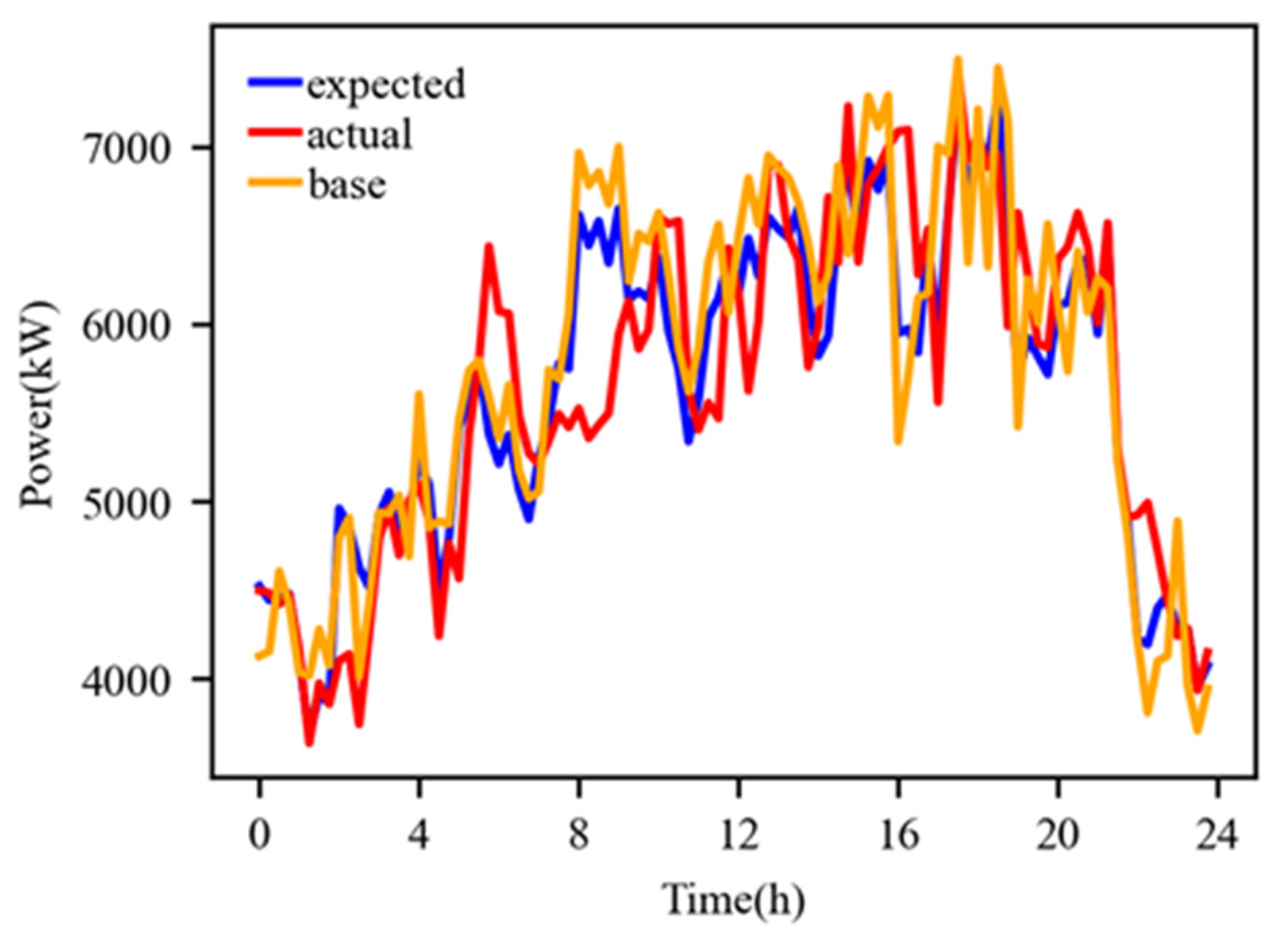

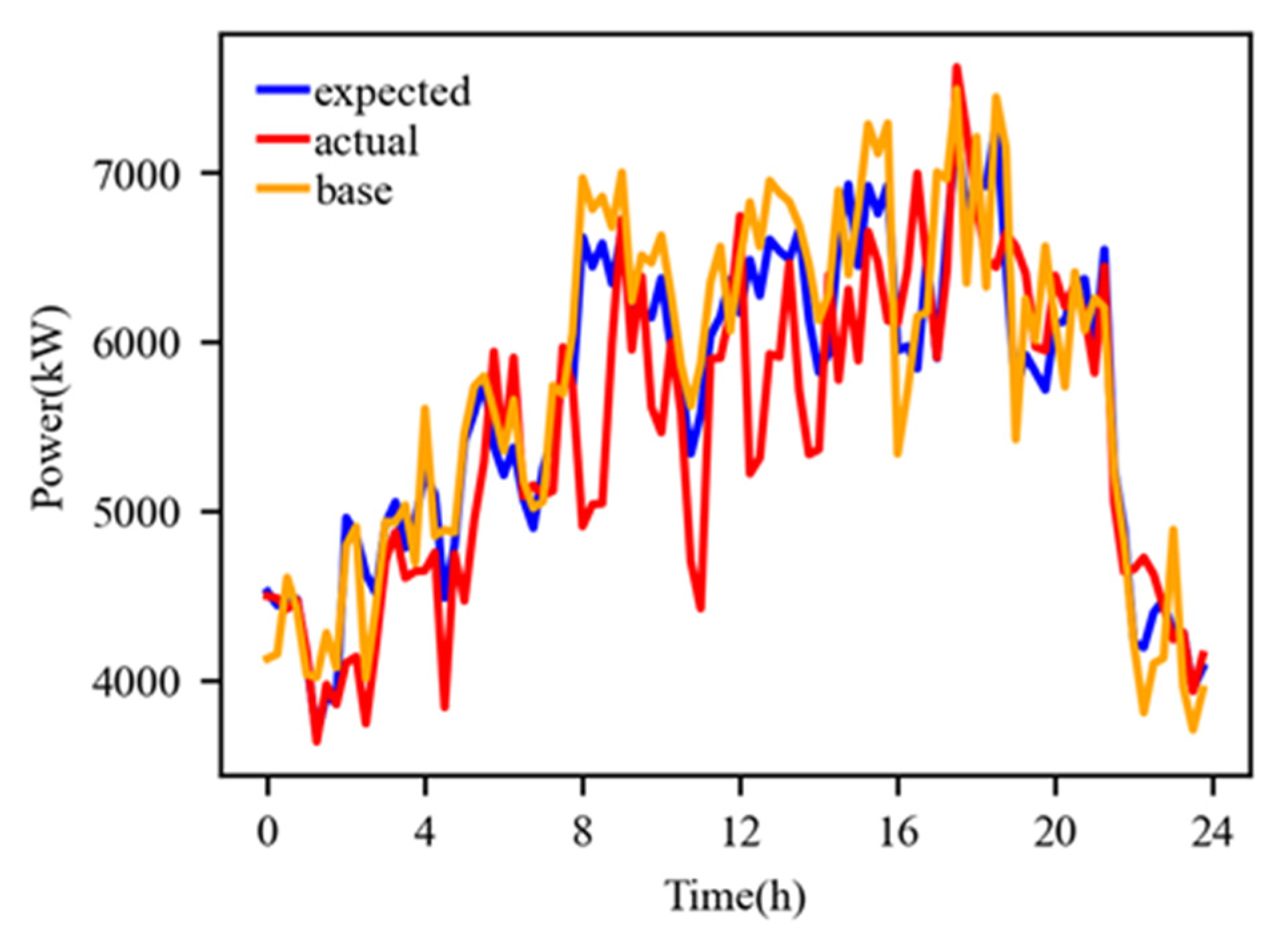
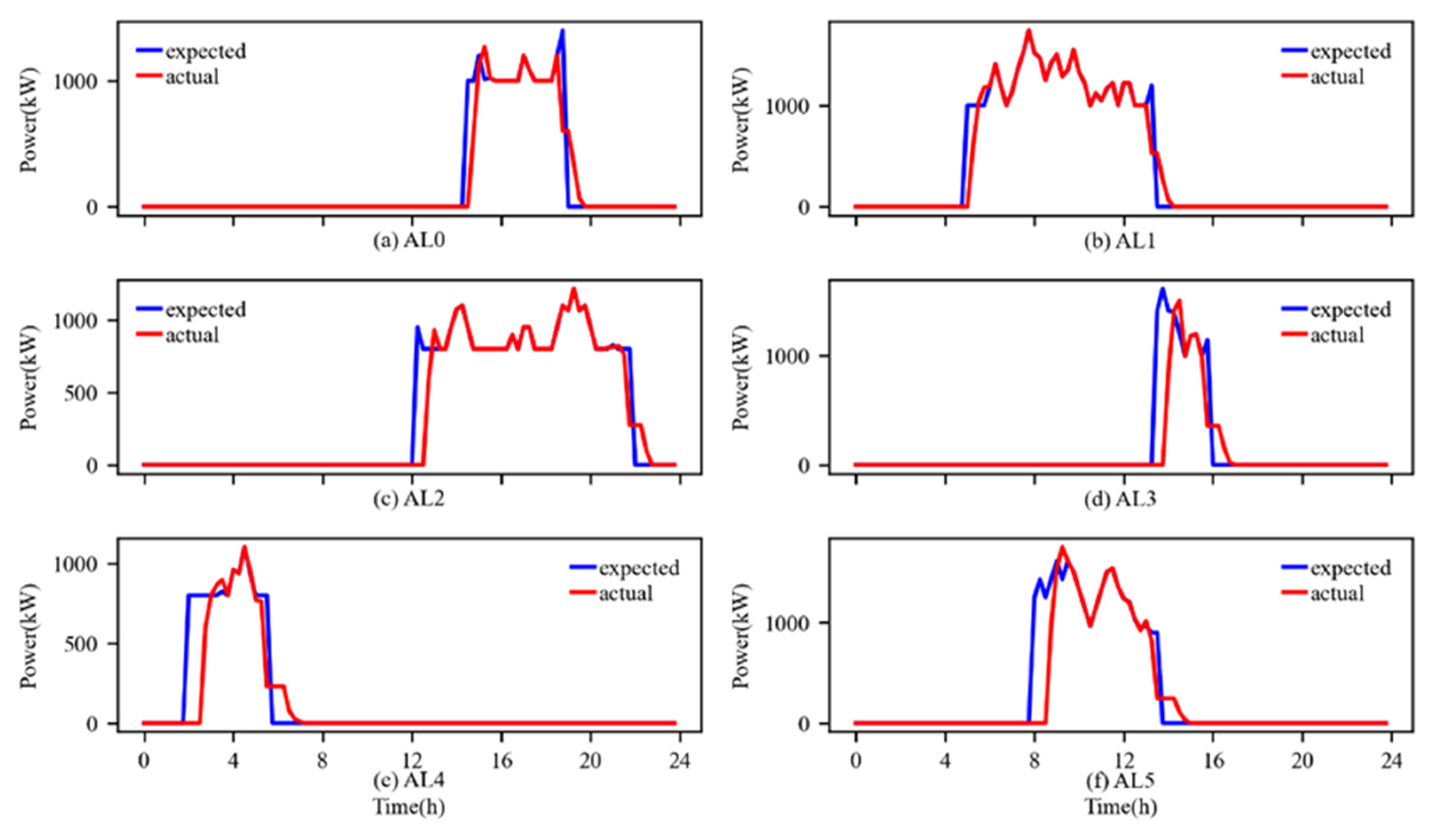
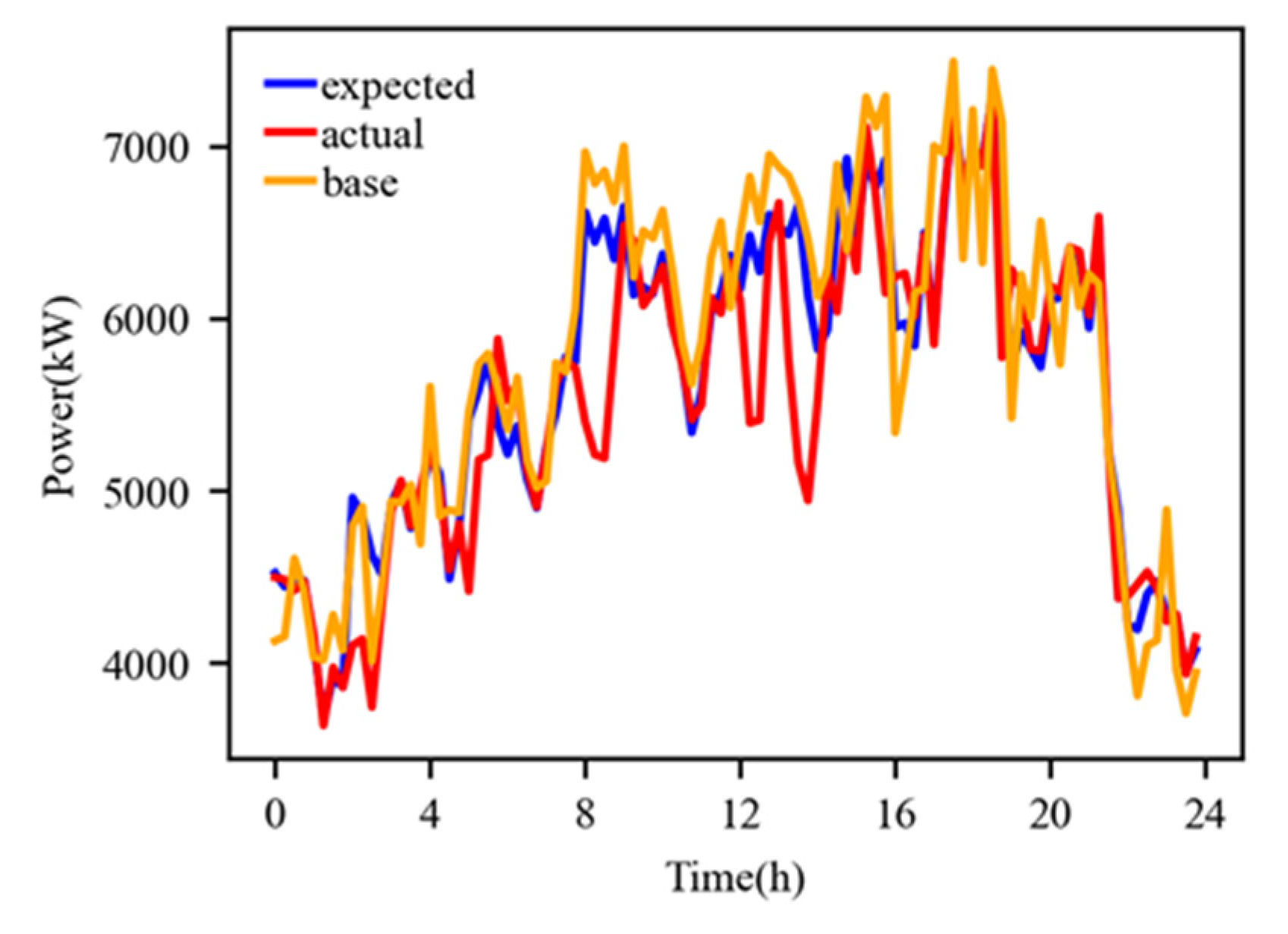
| Type | Time Period | Electricity Price (CYN/kWh) |
|---|---|---|
| Peak | 10:00–12:00, 14:00–19:00 | 1.1767 |
| Flat | 08:00–10:00, 12:00–14:00, 19:00–24:00 | 0.7036 |
| Valley | 00:00–08:00 | 0.2845 |
| Controllable load object AL0: | |
| Range of operating power | |
| Single continuous operating time | 4 |
| Daily operating time constraint | |
| Daily start–stop frequency limit | 1 |
| Daily operating time interval constraint | |
| Controllable load object AL1: | |
| Range of operating power | |
| Single continuous operating time | 2 |
| Daily operating time constraint | |
| Daily start–stop frequency limit | 2 |
| Daily operating time interval constraint | |
| Controllable load object AL2: | |
| Range of operating power | |
| Single continuous operating time | 10 |
| Daily operating time constraint | |
| Daily start–stop frequency limit | 2 |
| Daily operating time interval constraint | |
| Controllable load object AL3: | |
| Range of operating power | |
| Single continuous operating time | 2.5 |
| Daily operating time constraint | |
| Daily start–stop frequency limit | 1 |
| Daily operating time interval constraint | |
| Controllable load object AL4: | |
| Range of operating power | |
| Single continuous operating time | 3.5 |
| Daily operating time constraint | |
| Daily start–stop frequency limit | 1 |
| Daily operating time interval constraint | |
| Controllable load object AL5: | |
| Range of operating power | |
| Single continuous operating time | 5.5 |
| Daily operating time constraint | |
| Daily start–stop frequency limit | 1 |
| Daily operating time interval constraint | |
| Scenario One (CYN) | Scenario Two (CYN) | Scenario Three (CYN) | Scenario Four (CYN) | |
|---|---|---|---|---|
| Expected cost of purchasing electricity | 398,618.06 | 399,991.38 | 399,991.38 | 399,991.38 |
| Actual cost of purchasing electricity | 403,184.11 | 402,262.37 | 386,169.39 | 390,995.81 |
| Expected assessment cost | 15,628.36 | 15,063.10 | 15,063.10 | 15,063.10 |
| Actual assessment cost | 75,260.48 | 72,245.10 | 87,097.48 | 62,826.08 |
| Expected total cost | 414,246.42 | 415,054.48 | 415,054.48 | 415,054.48 |
| Actual total cost | 478,444.60 | 474,507.47 | 473,266.87 | 453,821.90 |
Disclaimer/Publisher’s Note: The statements, opinions and data contained in all publications are solely those of the individual author(s) and contributor(s) and not of MDPI and/or the editor(s). MDPI and/or the editor(s) disclaim responsibility for any injury to people or property resulting from any ideas, methods, instructions or products referred to in the content. |
© 2023 by the authors. Licensee MDPI, Basel, Switzerland. This article is an open access article distributed under the terms and conditions of the Creative Commons Attribution (CC BY) license (https://creativecommons.org/licenses/by/4.0/).
Share and Cite
Zheng, Q.; Yang, P.; Wu, Y.; Xu, Z.; Zhang, P. Aggregation Dispatch and Control Strategies for Multi-Type Loads in Industrial Parks. Appl. Sci. 2023, 13, 9205. https://doi.org/10.3390/app13169205
Zheng Q, Yang P, Wu Y, Xu Z, Zhang P. Aggregation Dispatch and Control Strategies for Multi-Type Loads in Industrial Parks. Applied Sciences. 2023; 13(16):9205. https://doi.org/10.3390/app13169205
Chicago/Turabian StyleZheng, Qunru, Ping Yang, Yuhang Wu, Zhen Xu, and Peng Zhang. 2023. "Aggregation Dispatch and Control Strategies for Multi-Type Loads in Industrial Parks" Applied Sciences 13, no. 16: 9205. https://doi.org/10.3390/app13169205
APA StyleZheng, Q., Yang, P., Wu, Y., Xu, Z., & Zhang, P. (2023). Aggregation Dispatch and Control Strategies for Multi-Type Loads in Industrial Parks. Applied Sciences, 13(16), 9205. https://doi.org/10.3390/app13169205





